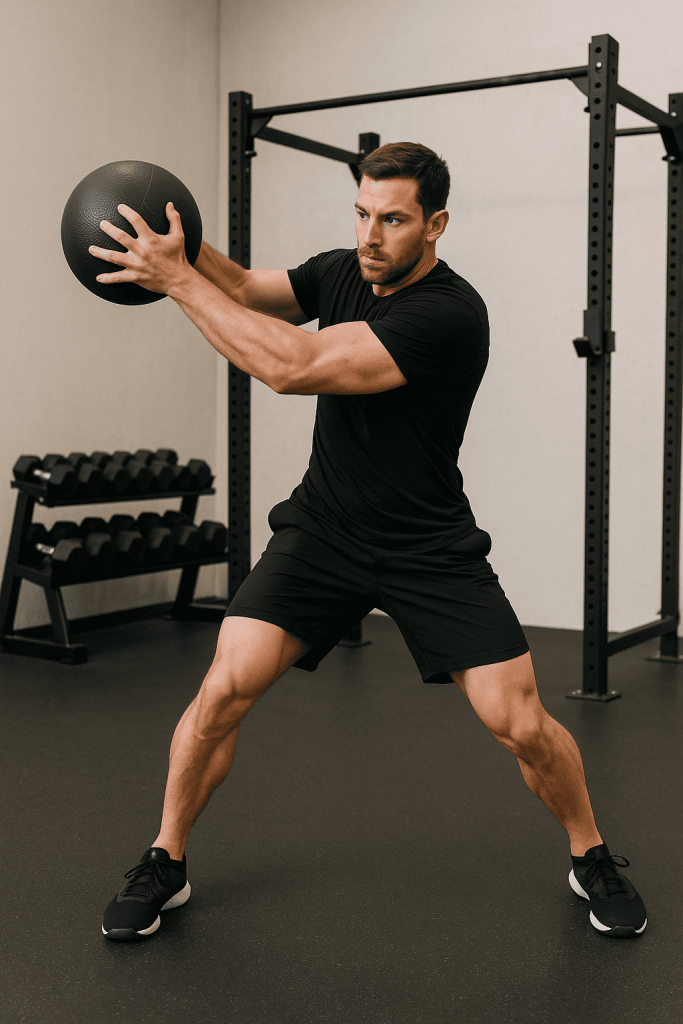12 de May de 2025
Rotational Medicine Ball Slams: Exercise Guide, Tips and Benefits
Rotational medicine ball slams are a high-intensity, power-focused movement that combines rotational force, coordination, and core engagement. Unlike traditional overhead slams, this variation challenges the body in the transverse plane—making it highly relevant for athletes who perform twisting or cutting motions. It’s a full-body exercise that enhances explosive strength, core control, and metabolic conditioning.
What Are Rotational Medicine Ball Slams?
Rotational slams involve swinging a medicine ball across your body and forcefully slamming it into the ground beside you. The movement begins with a wind-up from one side and finishes with a dynamic pivot and slam to the opposite side. This pattern targets the core—especially the obliques—while training rotational power, coordination, and reactive strength. It’s ideal for athletic development and functional strength in sports requiring rapid torso rotation.

How to Do Rotational Medicine Ball Slams Properly
- Stand tall: Feet shoulder-width apart, medicine ball in both hands at chest height.
- Rotate to one side: Load your hips and wind up by turning your torso.
- Slam the ball: Pivot through your hips and throw the ball down to the ground on the opposite side.
- Reset and repeat: Retrieve the ball or use a wall rebound to continue reps.
- Perform 2–4 sets of 8–12 reps per side with maximum power.
Tip: Drive the movement from your core and hips—not just your arms. Keep your spine neutral and avoid overextending the back.
Muscles Worked by Rotational Medicine Ball Slams
This explosive movement activates multiple muscle groups:
- Obliques and transverse abdominis: Drive rotation and stabilize the trunk.
- Glutes and hips: Provide power through the pivot.
- Shoulders, lats, and arms: Assist in the swinging and slamming motion.
- Quads and calves: Help with balance and lower body support.
Benefits of Rotational Medicine Ball Slams
- Explosive Rotational Power: Trains fast-twitch fibers through dynamic rotation.
- Improved Core Control: Builds functional core strength for sport-specific movements.
- Athletic Transfer: Mimics rotational demands found in sports like baseball, tennis, and martial arts.
- Full-Body Conditioning: Elevates heart rate and improves metabolic fitness.
- Reduced Fatigue: Serves as an effective way to train explosively without heavy lifting.
Common Mistakes to Avoid
- Leading with the Arms: The power should come from the hips and torso.
- No Hip Rotation: Keep your foot and hip movement fluid to avoid low back strain.
- Poor Ball Control: Use a slam ball that won’t bounce unpredictably.
- Insufficient Warm-Up: Always prime your core and hips before ballistic movements.
Variations of Rotational Medicine Ball Slams
- Wall Rebound Slam: Slam the ball against a wall at an angle to work reactivity.
- Alternating Slams: Switch sides after each rep for continuous motion.
- Single-Side Focus: Perform all reps on one side before switching.
- Split-Stance Slam: Add a staggered stance for increased lower-body challenge.

How to Include Rotational Medicine Ball Slams in Your S&C Workout
Use these slams in warm-ups, power blocks, or conditioning finishers. Perform them 1–3 times per week, depending on training goals. They’re especially useful in rotational athlete programs and can serve as a lower-impact alternative to loaded power work, helping manage fatigue without sacrificing intensity.
FAQs About Rotational Medicine Ball Slams
What do rotational med ball slams work?
They target the obliques, hips, shoulders, and core—building rotational power, coordination, and explosive strength.
What muscles does slamming a medicine ball work?
Slams engage the entire body: core, shoulders, back, glutes, and legs all contribute to force generation and control.
Should you push or pull med ball slam?
You should pull through your core and rotate your hips explosively—it’s a torque-driven motion, not a linear push or pull.
Do medicine ball slams increase punching power?
Yes, by training explosive rotation and hip drive, med ball slams can enhance the mechanics behind powerful punches.
What is the best weight for med ball slams?
Start with 4–6 kg (8–12 lbs) for power and speed. Heavier balls can be used for strength, but avoid compromising form or velocity.
Rotational medicine ball slams are a dynamic and effective way to develop rotational strength, coordination, and explosive power. Whether you’re training for athletic performance or simply diversifying your conditioning, they add functional intensity to your strength and conditioning workouts—while helping manage training fatigue in a powerful, low-impact format.
